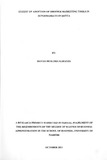| dc.description.abstract | The objectives of this study was to establish the extent of adoption of shopper marketing tools in supermarkets in Kenya and determine the benefits of adopting shopper marketing tools to the manufacturers and/or the supermarket. The findings of this study will offer several insights to guide shopper marketing strategies.
The study employed a cross sectional survey design whereby data from the entire medium and large supermarkets in Kenya were sought. The research was descriptive in nature. The target population of this study was all the medium and large supermarkets in Nairobi and its environs. These were the primary target of the study. The questionnaire was the only primary data collection instrument. The questionnaire was designed to address the research questions. Data collected was both qualitative and quantitative in nature. Data from the questionnaires were analyzed based on descriptive statistics. The results from the analysis were then presented using tables, pie charts and bar graphs for easier interpretation.
Findings indicate that end aisle displays, in-store staff, shelf advertisement or wobblers, coupon dispensers and shelf advertisements were the most effective and common forms of shopper marketing used by supermarkets in Kenya. Display bins, free standing advertisements and cutouts and floor advertisements were the least used by the supermarkets. Other tools applied but by the bigger supermarkets included video, shopping cart advertisements, end aisle displays, free standing product display racks, and shelf advertisement. Benefits from shopper marketing included increased sales, improved customer loyalty and overall return on investment.
The recommendations made after considering the findings include: First,supermarkets should first assess the contribution of shopper marketing tools to overall performance of the store before adopting such tools. Shopper tools should be applied to maximize returns. Secondly, marketers should invest time and resources to design shopper tools that are appealing to customers. In designing a winning shopper marketing strategy, the following must be in place: shopper-centric thinking; a shopper-centric culture; an intimate, household-level understanding; brilliant execution; continual measurement/ improvement and strategic collaboration which are more efficient than the traditional marketing methods. | en |

